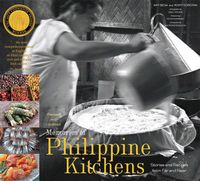Advertisement
The Origin of Bibingka
Appears in
By Amy Besa and Romy Dorotan
Published 2006
No one really knows where the bibingka came from. We do know that there are sweet cakes in Goa called bibinca (or bebinca), and the term was also used for similar variations of the dessert in other Portuguese colonies such as Timor and Macau. The Goan dessert is described as a cake made by baking a batter of rice, sugar, and coconut milk, layer by layer, between spoonfuls of ghee. There are similarities to the Filipino bibingka in that the heat that cooks it comes from the top, not the bottom.
The Goan layered rice cake resembles the Indonesian and Malaysian dessert lapis legit or spekkoek, a Dutch term which, oddly, means “bacon cake.” The Spanish, Portuguese, and Dutch colonizers of Southeast Asia were constantly sending ships back and forth, and Manila was a major port for trade and a melting pot of cultures, goods, and people.

